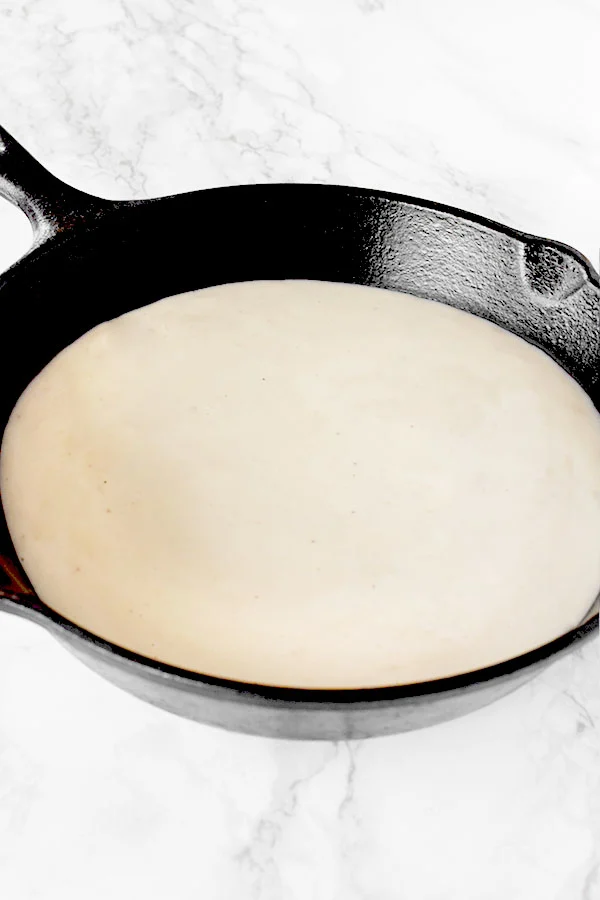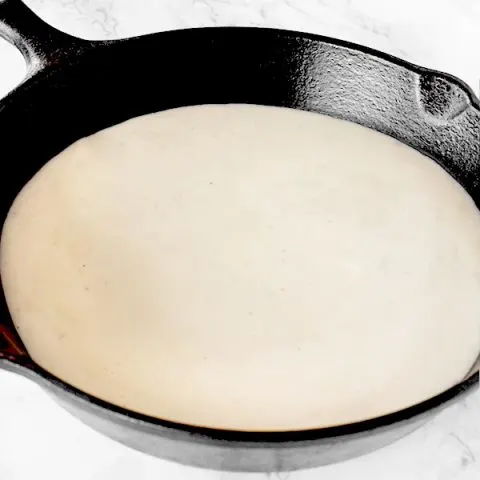This dairy free white sauce, or dairy free bechamel sauce, is a dairy free version of the French classic sauce and is a key ingredient for many dishes.

Dairy free white sauce, or dairy free bechamel sauce, is a must for dishes such as Dairy Free Italian Lasagna and Dairy Free Scalloped Potatoes.
The French term for this medium-thick white sauce is béchamel and it is important as a base for soufflés.
Italians and Greeks are more fond of using it in pasta casseroles with a ragú.
Does bechamel sauce contain dairy?
Usually yes, Behcamel sauce typically contains butter and milk. However, they can be replaced with dairy free milk and oil like in this recipe.
Are Bechamel sauce and Alfredo sauce the same?
No, Bechamel sauce and Alfredo sauce are two different sauces. Alfredo sauce includes cheese and heavy cream.
WHAT IS A ROUX
A roux is flour and fat cooked together until it reaches a specific color.
It is used as a thickening agent for gravy, sauces, soups, and stews and has been used in French cooking for hundreds of years to thicken sauce.
The flour is added to the melted fat or oil on the stove top, blended until smooth, and cooked to the desired color.
A roux can be white and used for country gravy, blond for classic gravies, or brown, which is used in gumbo and jambalaya.
The lighter the roux, the more thickening power it has.
Once the roux is the desired color, liquids like stock are added.
Browning Flour
People often see instructions like "brown the flour" and avoid this step because they aren't making brown gravy.
Browning flour means you're cooking the flour. This removes the flour flavor so it won't ruin the taste of your gravy.
WHY USE FLOUR TO THICKEN Sauce
Many people don’t like using flour because if it isn’t cooked long enough, it can give a floury flavor. Also, if not made properly, it can become clumpy.
The good news is, making a smooth creamy sauce or gravy is a snap if you turn it into a roux first.
Another benefit some people see with gravy made with flour is that it keeps better in the fridge. This means it can be made ahead of time or used as leftovers.
What Kind of Oil to Use
Neutral oils like vegetable oil, safflower oil, and sunflower seed oil work well here.
Flavored oils like olive oil and coconut oil can be used as well, but may add an undesired flavor to your dish.
Schmaltz or other rendered animal fats can also be used in place of oil and may add a nice savory flavor.
Gluten Free
For a gluten free version, skip the roux. Instead, heat the milk and add a slurry to it.
WHAT IS A SLURRY
Slurries are commonly used in Asian cooking and Chinese-American cuisine. It is used to make sauces needed for recipes like Beef Broccoli and Pepper Steak.
A slurry, like a roux, is used to thicken gravies, sauces, stews, and soups. However, unlike a roux, it is added at the end of the recipe and is gluten free.
It is a combination between corn starch or potato starch and water and provides a silky texture.
While it is less common, slurries can be made with flour.
How to make a slurry
To make a slurry, use half the amount of flour that the recipe calls for. Then, slowly add water to it until you get a thin paste.
Cornstarch
Starch is a natural component of almost all grains and some fruits and vegetables.
One of starch’s compelling properties is its ability to absorb and retain lots of liquid.
Starches are incredibly versatile ingredients. They cause the liquid to thicken and add moisture as well as a tender and delicate texture in baked goods.
They can also be combined with water as an egg replacement for eggless and vegan recipes, working as a binder and to add moisture.
In addition, starches are sometimes used to make a coating for frying, which creates a crispy texture on fried foods like fried chicken.
It's also not uncommon to find starch used as a stabilizer.
Cornstarch is one of the most versatile starches there are. It is a terrific ingredient for thickening sauces, puddings, soups, and pie fillings and is also used in many baked good recipes.
Cornstarch Uses
Cornstarch is an underrated and underused ingredient in home kitchens. Here are a number of ways cornstarch can be used:
Cornstarch for thickening soups, stews, and gravies
Cornstarch is often used as a thickening agent when added to soups, stews, and gravies.
This is usually done by making a slurry which is then added to whatever is in need of thickening.
Cornstarch in baked goods
Starch helps keep breads, cakes, quick breads, muffins, cupcakes, and brownies fresh by absorbing and holding liquid.
For breads, you can replace up to ¼ cup of all-purpose flour with cornstarch out of every three cups of flour.
For cakes, quick breads, muffins, and cupcakes, you can replace 2 tablespoons out of every cup of all-purpose flour.
Cornstarch in Cookies
Cornstarch gives cookies a soft center, helps prevent them from spreading, and adds chewiness.
Add ½ to 1 teaspoon of cornstarch per cup of flour called for in the recipe.
Cornstarch for Chewy Brownies
For chewy brownies that taste like those from the box, add 1 tablespoon of cornstarch per ½ cup of flour.
How to substitute Cornstarch
Cornstarch is one of a number of starches available - though it tends to be the easiest to find.
The best alternative to cornstarch in my opinion is potato starch.
You should substitute potato starch for cornstarch in a 1:1 ratio. This means if you need 1 tablespoon of cornstarch, use 1 tablespoon of potato starch instead.
Which dairy free milk should I use?
Honestly, it's whatever you have on hand or prefer.
My go-to is a neutral flavored full fat oat milk because I find that they are the most similar to regular full fat milk.
Almond milk works well here, too. I personally like using an unsweetened barista almond milk because it is more similar to regular full fat milk, but whatever you have will work.
You can also use coconut milk, though it may have a subtle coconut flavor if you do. Coconut milk has more fat and is similar to using a light cream, but it won't make a noticeable difference.
I've never used soy milk, so I don't have any opinions on it, but you can use that as well.
Can it be made ahead of time?
Yes. You can make this sauce a day or two before and simply reheat it shortly before you're ready to serve.
Let sauce cool completely and cover it with wax paper or pour a film of milk over it to prevent a skin from forming.
How to Store
Once the sauce has cooled, place it in an air tight container. Keep up to 5 days in the refrigerator.
How to Freeze
Once the sauce has cooled, place it in an airtight container or a resealable freezer bag.
You can freeze sauce for up to 5 months. After that, it is still safe to eat, but the quality begins to degrade.
How to Reheat
Gravy will thicken as it cools. When you reheat it, add dairy free milk or water until it is smooth and reaches your desired consistency again.
Dairy Free White Sauce (Bechamel Sauce)

Dairy free white sauce made without milk. Perfect for dairy free scalloped potatoes and dairy free lasagna.
Ingredients
- 1 ½ tablespoons oil
- 2 tablespoons flour
- 1 cups dairy free milk, heated
- Salt and freshly ground pepper to taste
Instructions
- Heat oil in a heavy-bottomed saucepan or skillet.
- Stir in the flour and cook, stirring constantly, until the paste cooks for about 2 minutes, but don't let it brown.
- Add the hot dairy free milk, continuing to stir as the sauce thickens. Bring it to a boil.
- Add salt and pepper to taste, lower the heat, and cook, stirring for another 2 to 3 minutes. Remove from the heat.
Notes
If the gravy becomes too thick, you can thin it out with a little more water or dairy free milk.
Nutrition Information:
Yield:
1Serving Size:
1Amount Per Serving: Calories: 398Total Fat: 11gSaturated Fat: 7gTrans Fat: 0gUnsaturated Fat: 4gCholesterol: 44mgSodium: 597mgCarbohydrates: 55gFiber: 2gSugar: 1gProtein: 21g